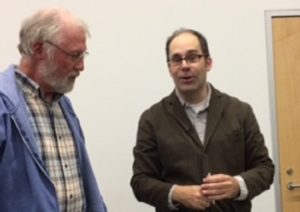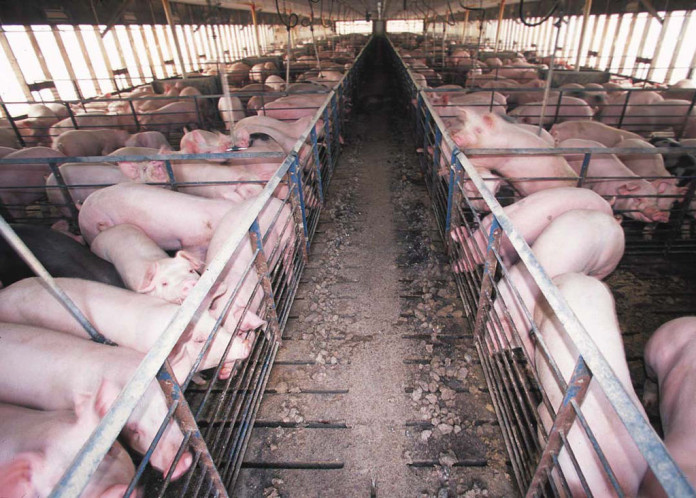Book Review: Robert Wallace, “Big Farms Make Big Flu,” Monthly Review Press, 2016.
Iowans will remember the spring of 2015, when bird flu devastated poultry flocks. More than 31.5 million birds, an astounding number and half of our state’s total, died as a result of the H5N2 virus or by culling in an effort to stop the disease outbreak. Reports estimated that this disease cost the Iowa economy $1.2 billion in lost wages, services, production and taxes.
What message did consumers get? By the way, each and every one of us is a consumer. We heard the warning that the price of a dozen eggs would double. Double!
There seemed to be little or no concern about the costs to our state or about the fact that birds were housed in confined, crowded facilities were the flu virus could run rampant. Some concern was raised about the possibility of transmission to humans.
We were extremely fortunate that people were not infected. This time.

A new book, “Big Farms Make Big Flu,” explains why these industrial, factory-style facilities and the confinement model that produces the majority of our meat, milk and eggs in the U.S. creates conditions that increase the likelihood that diseases such as the 2015 bird flu will continue to plague our agricultural areas and could too easily spread to humans.
Rob Wallace, evolutionary biologist and author of “Big Farms Make Big Flu,” was at the Ames Public Library last fall to discuss his book and the research behind it.
Sponsored by the ISU Graduate Program in Sustainable Agriculture, the event drew a crowd of about 50 people, including sustainable agriculture students, farmers, activists and educators concerned about the rise and the risks of industrial agriculture’s animal confinement model.
Despite the seriousness of the topic, an upbeat and optimistic Wallace engaged with his audience while presenting the mechanisms that allow pathogens to become more virulent and dangerous in the mega-farm environment. His research examines the relations between socioeconomic and biological factors that have created and transmitted diseases in poultry and swine.
In his chapter on the 2015 bird flu, Wallace noted that state and industry leaders were slow to recognize the size of the problem. In fact, the tendency was to place the blame on anything but the industrial model. What did not get reported was the root of the problem: thousands and even millions of birds packed together in confinements.
In the January 2017 issue of the prestigious U.K. medical journal The Lancet, Marius Gilbert called Wallace’s book “a must-read for those concerned with emerging infectious diseases, and many other issues emerging from modern food systems.”
With a startling 22.4 million pigs in Iowa as of December 2016 and 60 million laying hens and with nearly all housed in confinement facilities known as CAFOs, every Iowan needs to be among Wallace’s concerned readers.
As Gilbert notes, “Wallace makes strong charges against neoliberalism for the limitless power it gave to agribusinesses to impose their externalities on societies.” The externalized costs related to “Big Farms” are the costs of pandemic disease killing millions of animals and the costs to our human health care.
But Wallace’s research and analysis is most compelling when he shows how virulent flu viruses, made possible by this industrialized meat and egg production model, is a serious public health threat.
As “Big Farms Make Big Flu” argues, the serious risk to the human population is not limited to the folks in Iowa. This industrial mass production of meat has grown to be a global industry.

Wallace’s research focuses on the hog industry and the H1N1 virus as an example. He documents how the increased risk of virulent influenza viruses is due to the large populations of animals, their crowded conditions and the continual supply of susceptible young animals with little genetic diversity.
He concludes that no matter what measures the industry takes, it causes viruses to evolve faster and become more virulent. As with the avian influenza, these hog CAFOs are built to guard against a variety of swine or bird diseases, but protections against influenza viruses are much more difficult to achieve. Even advanced biosecurity measures are not adequate against the most virulent pathogens.
Iowa’s farms and rural communities are faced with a vulnerability so great it could lead to catastrophe. No one wants that to happen, but too many people, especially those in leadership roles and in the agribusiness industry itself, seem to be in denial.
Many Iowans are now calling for a moratorium on new and expanding CAFOs. Perhaps it is time for Iowans to stand up and insist our state elected officials enact that moratorium now before another influenza virus turns into a human pandemic.
In fact, with a moratorium in place, Iowa could explore the many ways to support farmers and food production that do not include more CAFOs but instead promote a resilient agriculture system that creates food sovereignty for our communities and our state.
Food sovereignty, as defined by La Via Campesina, a worldwide farmers’ group, is the right of peoples to healthy and culturally appropriate food produced through sustainable methods and their right to define their own food and agriculture systems. It ensures that the rights to use and manage lands, territories, water, seeds, livestock and biodiversity are in the hands of those who produce food and not of the corporate sector.
Those rights seem to be forgotten in our current model of meat, milk and egg production. It’s time for change.
Sources:
Monthly Review: Common Good Books: The Lancet: Antipode: Iowa’s bird flu: Farming Pathogens: Leopold Center for Sustainable Agriculture


















There’s a big problem here. The human population has already topped the point where even I have to admit industrial livestock operations are essential. Yes, I too would like to see a moratorium on further development of such operations here in Iowa, but the fact remains these places are vital. We must work diligently with the current operators to minimize these risks. Many dear friends own or work at such places. Short of shutting them down, we all need to brainstorm together to find ways of minimizing the environmental impacts of the confinement operations as well as taking the steps needed to decrease the risks of disease in high animal concentrations. I would also like to see more effort in developing a sustainable agricultural system, including locally grown and organic produce as well as more free-range poultry, swine and cattle using heirloom breeds. Still, the sustainable agriculture we’re shooting for can only become feasible when we come to grips with one undeniable fact. We have far too many more humans than we can adequately feed now.